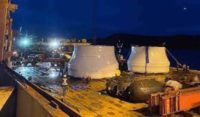Canadian leaders are pushing a $7.5-billion infrastructure plan to boost an array of renewable energy initiatives and jump start job growth amid the country's coronavirus downturn.
Prime Minister Justin Trudeau announced that the Canada Infrastructure Bank, criticized for what has been considered a sluggish pace of investment commitments since its 2017 launch, will take the lead on the new initiative.
It comes roughly a week after the Liberal government announced broad details of an infrastructure and economic pump-priming plan that includes extension of Canada's emergency wage subsidy until next summer.
The new investment plan, which target projects that can be more quickly started, also comes as the government struggles to make good on its existing $135 billion, 12-year infrastructure spending program.
Leading into the COVID-19 crisis, the amount of money committed to projects around the country under that program begun in 2016 had consistently lagged projections.
The latest initiative, which the infrastructure bank contends will spur creation of 60,000 jobs, won generally good reviews from engineering and construction industry leaders.
But it was not without some caveats.
While supportive of federal government and infrastructure bank plans to funnel investment dollars into renewable and green energy sectors, John Gamble, president and CEO of Canada's Association of Consulting Engineering Cos. (ACEC/Canada), noted that the planned infusion did not include larger construction investments in ports and transportation that are key to long-term economic growth.
The current program are for "projects that consume tax dollars rather than growing the economy,” Gamble said. “There needs to be attention to the types of investments that grow the economy.”
Gamble noted the plan does include $1.5 billion for broadband extensions to hook up 750,000 Canadian homes and small businesses to the internet, with another $1.1 billion for irrigation projects to expand food production and explore export opportunities.
But the program largely targets boosted green projects—with $1.9 billion for renewable generation and storage projects; $1.5 billion for energy-efficiency building retrofits; and $1.1 billion for zero-emission buses and charging infrastructure.
Analysts at the National Bank of Canada’s financial research arm also noted the absence of “nation-building type project announcements which could really move the needle.”
But their report also said the infrastructure bank-led spending plan “directly benefits construction players and engineering peers to a lesser degree.”
The $7.5 billion investment program represents about one-third of the federal seed money controlled by the bank, whose mission is to leverage that commitment to attract larger amounts of private investment capital into public infrastructure projects.
“The Infra Bank firing almost 1/3 of the [$26 billion] spending bullet is clear messaging that infrastructure will not be left languishing in the recovery blueprint,” the analysts noted.
Newly installed bank interim CEO Michael Sabia, former chief of a large Canadian pension fund, acknowledged the bank's past issues but said projects in Canada will attract international investors looking for long term results. He said the bank expects to announce specific project investments by the end of he year and will name a permanent bank chief within coming weeks.
The Canadian Construction Association calls the new plan a “promising step.” But it also seeks more “urgency” by the federal government and the infrastructure bank “in tendering the projects and a swift flow of funds”—a criticism that reflects long-standing concern that red tape and excessive regulation holds back Canadian infrastructure spending plans.
The trade group says the plan does not include money for needed work on roads and bridges, adding that oil and gas regions appear left out of the spending plan, the latter also echoed by ACEC/Canada.
“Our oil patch is suffering,” said Gamble. “The Canadian economy was built in no small part on the success of our oil and gas sector.”
Gamble acknowledges the government highlight of renewable energy investment but But he argues there needs to be more balance as well, with a need for more traditional, core infrastructure projects.
"You also have to make sure your foundation is sound and your roof doesn’t leak,” Gamble said.
Canada's conservative politicians and media were critical of the spending plan.






Post a comment to this article
Report Abusive Comment